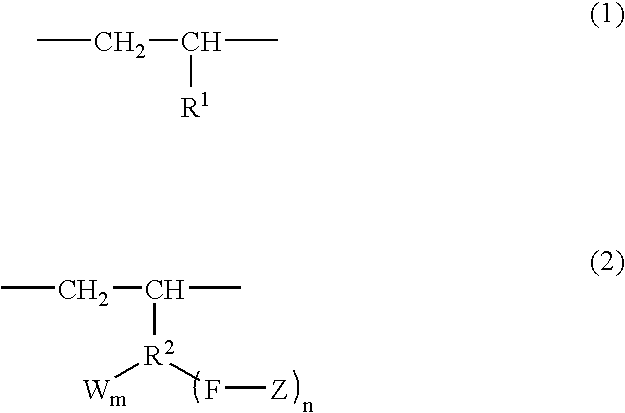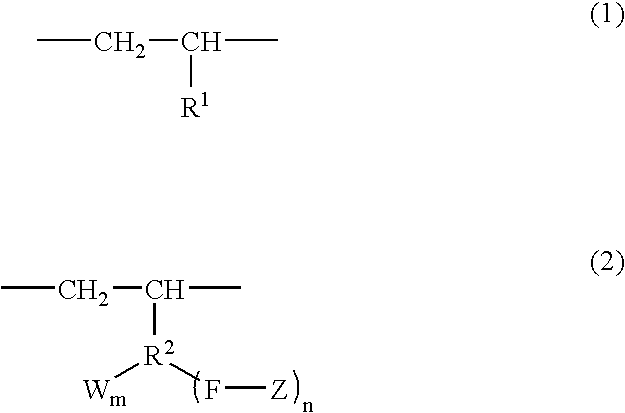Branched olefin copolymer, process for producing the same, and use thereof
- Summary
- Abstract
- Description
- Claims
- Application Information
AI Technical Summary
Benefits of technology
Problems solved by technology
Method used
Image
Examples
example 1
[0111] [Preparation of Polar Group-Containing Olefin Copolymer Modified with 2-Bromoisobutyryl Group]
[0112] 12 g ethylene / 10-undecen-1-ol copolymer (Mw=47200, Mw / Mn=1.98, comonomer content 3.6 mol %) produced according to a method described in Chem. Lett., 2001, 710-711 was introduced into a 1 L two-necked eggplant type flask purged with nitrogen, then 500 ml dry toluene, 32 ml triethylamine and 12.9 ml 2-bromoisobutyric acid bromide were added thereto, and the mixture was heated at 80.degree. C. and stirred under heating for 2 hours. The reaction solution was poured into 2 L methanol, and the precipitated polymer was filtered with a glass filter. The polymer on the glass filter was washed 3 times with 100 ml methanol, once with 100 ml of 1 N hydrochloric acid, and twice with 100 ml methanol. The polymer was dried at 50.degree. C. under the reduced-pressure condition of 10 Torr for 10 hours. As a result of .sup.1H-NMR, a polar group-containing olefin copolymer having 99% terminal OH...
example 2
[0115] [Production of a Branched Olefin Copolymer (PE-g-PMMA-2)]
[0116] A 100 ml Schrenk flask purged with nitrogen was charged with 215 mg (1.50 mmol) copper(I) chloride, 1.50 ml (3.0 mmol) of 2 M N,N,N,'N,",N,"-pentamethyldiethyltriamine in xylene, 9.62 ml (89.9 mmol) methyl methacrylate and 18.9 ml o-xylene, and then fit with a septum cap. From this solution, a uniform solution (A) from which dissolved oxygen was removed was prepared by a freeze pump and thaw method. Separately, the polar group-containing olefin copolymer (2-bromoisobutyric acid group-modified PE), 1.50 g (containing 1.50 mmol modified group), which was prepared in Example 1 was introduced into another 100 ml Schrenk flask purged with nitrogen, and the flask was fit with a septum cap. The above solution (A) was transferred to this Schrenk flask, heated to 120.degree. C. and reacted for 5 hours. The reaction mixture was cooled to room temperature, the reaction was terminated by adding about 5 ml methanol, and the r...
example 3
[0117] [Production of a Branched Olefin Copolymer (PE-g-(MA-co-BA)]
[0118] A 100 ml Schrenk flask purged with nitrogen was charged with 215 mg (1.50 mmol) copper(I) chloride, 1.50 ml (3.0 mmol) of 2 MN,N,N',N",N"-pentamethyldiethyltriamine inxylene, 2.5 ml (32.2 mmol) methyl acrylate, 4.0 ml (27.9 mmol) butyl acrylate, and 26.5 ml o-xylene, and then fit with a septum cap. From this solution, a uniform solution (A) from which dissolved oxygen was removed was prepared by a freeze pump and thaw method. Separately, the polar group-containing olefin copolymer (2-bromoisobutyric acid group-modified PE), 1.50 g (containing 1.50 mmol modified group), which was prepared in Example 1 was introduced into another 100 ml Schrenk flask purged with nitrogen, and then fit with a septum cap. The above solution (A) was transferred to this Schrenk flask, heated to 110.degree. C. and reacted for 3 hours. There action mixture was cooled to room temperature, the reaction was terminated by adding about 5 m...
PUM
| Property | Measurement | Unit |
|---|---|---|
| Thermoplasticity | aaaaa | aaaaa |
Abstract
Description
Claims
Application Information
 Login to View More
Login to View More - R&D
- Intellectual Property
- Life Sciences
- Materials
- Tech Scout
- Unparalleled Data Quality
- Higher Quality Content
- 60% Fewer Hallucinations
Browse by: Latest US Patents, China's latest patents, Technical Efficacy Thesaurus, Application Domain, Technology Topic, Popular Technical Reports.
© 2025 PatSnap. All rights reserved.Legal|Privacy policy|Modern Slavery Act Transparency Statement|Sitemap|About US| Contact US: help@patsnap.com



